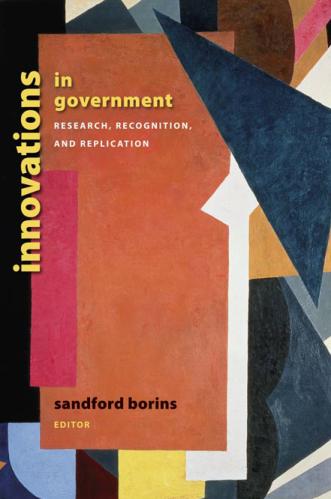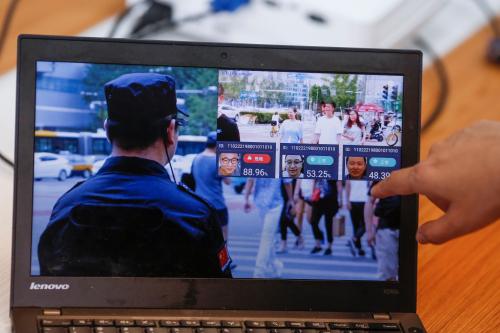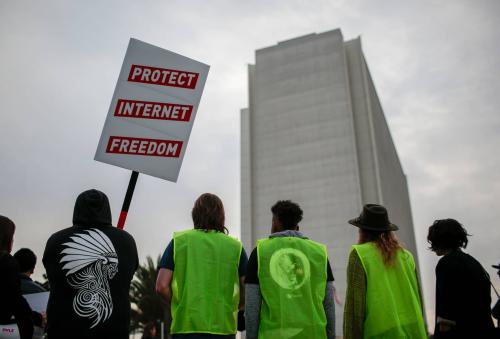For over two centuries, government officials and civil society groups have looked to the Bill of Rights for guidance on maintaining civil liberties while promoting public safety. Today, facial recognition technologies significantly augment the government’s ability to monitor or surveil individuals, prompting unique constitutional and ethical questions. On Dec. 5, Senators Chris Coons (D-DE) and Mike Lee (R-UT) joined Brookings scholars Darrell West and Nicol Turner-Lee to discuss how Congress and law enforcement officials can address privacy and civil liberties in the era of facial recognition.
Privacy and civil liberties
The Fourth Amendment prevents government officials from conducting “unreasonable searches and seizures” without first obtaining a probable cause warrant. To define what actions constitute “unreasonable searches,” courts have traditionally asked whether an individual has a “reasonable expectation of privacy” in a given context.
Under this “reasonable expectation of privacy” standard, courts have created a distinction between public spaces (such as shopping malls, sidewalks, or online chatrooms) and private spaces (such as homes or email accounts). While an individual’s actions or movements in public spaces generally fall outside the scope of Fourth Amendment protections, human limitations have historically constrained police monitoring. Facial recognition technologies, however, can increase both the efficiency and scope of police monitoring in traditionally public spaces.
Two recent Supreme Court cases have hinted that new technologies might affect interpretation or application of common law. In United States v. Jones (2012), the Supreme Court held that attaching a GPS tracking device to an individual’s car qualifies as a constitutional “search” under the Fourth Amendment—even though police officers may physically follow cars on public roads without a warrant. In Carpenter v. United States (2018), the Supreme Court held that law enforcement officials require a warrant to obtain cell phone location history, noting that “seismic shifts in digital technology” makes contemporary law enforcement “ever alert” and “nearly infallible.”
In both cases, the Supreme Court abstained from broadly defining “reasonable expectation of privacy” or “unreasonable searches” within the context of digital technologies, potentially leaving law enforcement officers with some uncertainty over the permissible use of facial recognition or other technologies.
Fairness and civil rights
Even if law enforcement officials obtain a warrant, the Fourth Amendment does not dictate how long the government may archive data following a lawful search or seizure. In general, law enforcement officials do not delete collected data following surveillance. In the context of facial recognition technologies, this practice could lead to comprehensive and long-lasting databases of identifiable faces, geolocation, and timestamps. Misuses of this data could include incorrect or irrelevant identification among other negative use cases—raising questions of when data minimization is necessary and how to implement it.
Incorrect identification presents civil rights issues if facial recognition systems show differences in accuracy or impact between legally protected classes. For example, if facial recognition software developers disproportionately use data from the criminal justice system, the resulting data pools could see systematic racial or gender biases. Accordingly, it is important to recognize whether the government’s use of facial recognition could contribute to or exacerbate existing societal biases.
Facial Recognition Technology Warrant Act
To address these privacy and fairness concerns, Coons and Lee introduced the Facial Recognition Technology Warrant Act last month. The bill requires federal law enforcement officials to obtain a probable cause warrant before utilizing facial recognition to track an individual’s public movements for a period over 72 hours, and limits tracking to 30 days. Furthermore, it requires federal law enforcement agencies to partner with the National Institute of Standards and Technology (NIST) to test the accuracy of facial recognition systems.
The senators explained that this legislation is an introductory attempt to set clearer facial recognition legal standards in one important use case, that of federal law enforcement. When navigating two extremes—a total ban on the use of facial recognition by law enforcement or a “Wild West where these powerful technologies are unregulated”—Coons and Lee suggested that there is a middle ground of devising guardrails that place some limitations on facial recognition while still allowing ongoing personal surveillance in cases of imminent threats or other security concerns.








Commentary
Highlights: Setting guidelines for facial recognition and law enforcement
December 9, 2019